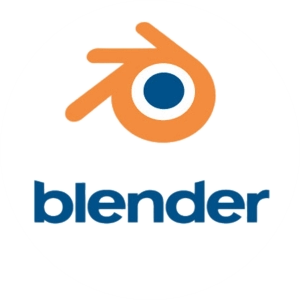
-
Blender – Detailed Explanation : A software for 3D animation, modeling, and visual effects.
Blender is a powerful, open-source 3D creation suite used for modeling, animation, rendering, game development, visual effects (VFX), and more. Below is a detailed breakdown according to your requested categories.
1- On which platform are the tools used?
Blender is a cross-platform software that works on:
✅ Operating Systems (For Development)
- Windows (Windows 8.1, 10, 11)
- macOS (macOS 10.13+ with Metal support)
- Linux
✅ Supported Formats (For Exporting/Importing)
- 3D Models: OBJ, FBX, STL, PLY, GLTF
- Video Editing: AVI, MP4, MOV, MKV
- Textures & Images: PNG, JPG, HDR, EXR
⚠️ Note: Blender does not have a mobile version, but it can export models for mobile apps (Unity, Unreal Engine, etc.).
2- What hardware requirements are needed?
Blender can run on most modern computers, but for heavy rendering and animation, higher-end hardware is recommended.
✅ Minimum Requirements (Basic Use – 3D Modeling)
- Operating System: Windows 8.1/macOS 10.13/Linux
- Processor: Dual-core CPU (Intel or AMD)
- RAM: 4GB
- Graphics: Integrated GPU (Intel HD Graphics 5000 or newer)
- Storage: 500MB of free disk space
✅ Recommended Requirements (Rendering, Animation, VR)
- Processor: Quad-core CPU (Intel i7/i9 or AMD Ryzen 7/9)
- RAM: 16GB or more
- Graphics: NVIDIA RTX 3060/4060 or AMD Radeon RX 6700 XT
- Storage: SSD (for faster loading times)
- VR Support: NVIDIA RTX 3080+ for VR applications
⚠️ High-end GPUs improve rendering performance significantly (CUDA/OptiX for NVIDIA, OpenCL for AMD).
3- Installation and Membership Stages
Installation Steps
- Download Blender from the official website: https://www.blender.org/download.
- Install Blender by running the setup file (Windows: .exe, Mac: .dmg, Linux: .tar.xz).
- Launch Blender and start using it immediately (no login required).
Membership
- Blender does not require an account to use.
- However, you can create a Blender ID to access:
✅ Blender Cloud (extra resources and assets).
✅ Add-ons and community support.
✅ Auto-syncing settings across devices.
4- What can it be used for?
Blender is a multi-purpose 3D tool and is used in various fields:
✅ 3D Modeling – Create characters, objects, environments.
✅ Animation & Rigging – Character animation, motion graphics.
✅ Game Development – Models, textures, and assets for Unity/Unreal.
✅ VFX & Motion Graphics – CGI, compositing, film effects.
✅ Architectural Visualization – Interior and exterior 3D rendering.
✅ Product Design & Engineering – Prototyping, simulations.
✅ 3D Printing – Create STL models for 3D printers.
✅ Virtual Reality (VR) & Augmented Reality (AR) – Creating VR worlds.
✅ Video Editing – Built-in video editor.5- What is its prominent feature compared to other tools?
🟢 Completely free & open-source – No licensing fees.
🟢 All-in-one tool – 3D modeling, animation, rendering, sculpting, and video editing.
🟢 Cycles & Eevee Render Engines – Fast, realistic rendering.
🟢 Python Scripting – Automate tasks and create add-ons.
🟢 VR & AR support – Export models for VR headsets.
🟢 Wide industry use – Used by NASA, Ubisoft, Netflix, and Hollywood studios.🔹 Compared to Autodesk Maya & 3ds Max: Blender is free, while Maya/Max require paid licenses.
🔹 Compared to ZBrush: Blender is more versatile (not just sculpting).
🔹 Compared to Cinema 4D: Blender has stronger open-source support but fewer built-in motion graphics tools.6- Sample Application Made with Pictures
Example: Creating a Simple 3D Chair Model
This is a basic example to demonstrate 3D modeling in Blender.
Step 1: Open Blender and Select “General” Template
- Start a new project and delete the default cube.
Step 2: Create Chair Components
- Use Add → Mesh → Cube to create chair legs and seat.
- Scale and position them using S (Scale), G (Move), and R (Rotate) keys.
Step 3: Add Materials & Textures
- Go to Shading Tab and add a wood texture for a realistic look.
Step 4: Render the Scene
- Switch to Cycles Render for realistic lighting.
- Add a light source (sunlight or HDRI).
📌 Example Screenshot
7- Which courses can it be used in and is compatible with?
Blender is widely used in vocational and technical education, including:
✅ Computer Science – Game development, scripting with Python.
✅ Architecture & Construction – 3D modeling of buildings.
✅ Mechanical & Mechatronics Engineering – Product design, 3D visualization.
✅ Animation & Digital Arts – 3D character creation, VFX.
✅ Automotive & Aerospace – Vehicle modeling, aerodynamics visualization.
✅ Robotics & AI – Simulation and visualization.
✅ Graphic Design – Motion graphics, 3D typography.
✅ Occupational Health & Safety – Training simulations in VR.8- Is it free?
✅ Yes! Blender is 100% free and open-source.
- No subscription or license required.
- Can be used for commercial projects with no restrictions.
- Supported by the Blender Foundation and donations.
9- Links Related to Blender
🔗 Official Website: https://www.blender.org
🔗 Download Blender: https://www.blender.org/download
🔗 Blender Cloud (Training & Assets): https://cloud.blender.org
🔗 Beginner Tutorials: https://www.blender.org/support/tutorials
🔗 Blender Documentation: https://docs.blender.org
🔗 Blender Market (Add-ons & Plugins): https://blendermarket.com